A High Temporal-Spatial Resolution Temperature Sensor for Simultaneous Measurement of Anisotropic Heat Flow
Abstract
1. Introduction
2. Sensor Preparation
2.1. Sensor Design
2.2. Sensor Temperature Calibration
3. Sensor Performance Test
3.1. In-Plane Thermal Measurement
3.2. COMSOL Simulation Calculation of Thermal Conductivity
3.3. Out-of-Plane Thermal Measurement
3.4. Heat Flow Calculation
3.5. Sensor Response Time Measurement
4. Practical Application of Pt Film Sensing Unit to Measure the Flame Temperature
5. Conclusions
- (1)
- The minimum line width of the thermal sensing unit is set to 5 μm, and the micrometer-level thermal sensing unit ensures the spatial scale of local detection. By arranging a large number of sensor units, the temperature and heat flow on the surface of the aircraft can be detected at a fixed point. Due to the extremely small characteristic size of the sensor, the theoretical temperature response time of the Pt nano-film sensor is at a sub-microsecond order.
- (2)
- The specially designed three-layer aluminum nitride ceramic sheet structure not only enables the function of anisotropic heat flow measurement but also protects the thermal sensing unit from high-temperature electrochemical corrosion and large deformation caused by the external airflow temperature difference.
- (3)
- Through experimental verification, the temperature measurement accuracy of the sensor can reach 0.01 K, the resolution of heat flow density is better than 500 W/m2, and the uncertainty of heat flow measurement is about 3%.
- (4)
- The high sensitivity of the new sensor in thermal measurement was verified by high-temperature flame pneumatic heating experiments, which confirmed the practical application of the sensor in the thermal measurement of hypersonic vehicles.
Supplementary Materials
Author Contributions
Funding
Institutional Review Board Statement
Informed Consent Statement
Conflicts of Interest
Nomenclature
| R1 | standard resistance, Ω |
| R2 | resistance of the Pt film sensing unit, Ω |
| V1 | voltage value of standard resistance, V |
| V2 | voltage value of the Pt film sensing unit, V |
| β | resistance temperature coefficient,/°C |
| T | absolute temperature measured by the sensor, K |
| R0 | initial resistance of the thermal sensing unit, Ω |
| T0 | initial temperature of the environment, K |
| thermal conductivities of the Pt film, W/m/K | |
| thermal conductivities of the aluminum nitride ceramic layer, W/m/K | |
| t | temperature in heat conduction differential equation, K |
| x, y, z | positions corresponding to the coordinate axes, m |
| internal heat source, W/m3 | |
| thermal conductivity in heat conduction differential equation, W/m/K | |
| interfacial thermal conductivity, W/m/K | |
| P | power applied to the thermal sensing unit, W |
| V | volume of a thermal sensing unit, m3 |
| TB | temperature of the simulation results on the high voltage side, K |
| TS | temperature of the simulation results on the low voltage side, K |
| TB0 | temperature of the experimental results on the high voltage side, K |
| TS0 | temperature of the experimental results on the low voltage side, K |
| calculation error | |
| T1, T2 | temperatures of two adjacent thermal sensing units, K |
| L | distance between adjacent thermal sensing units, m |
| q | heat flow density, W/m2 |
| t’ | time, s |
| time constant of the sensor, s | |
| equivalent surface heat transfer coefficient, W/m2/K | |
| area of temperature measurement unit, m2 | |
| density of platinum, kg/m3 | |
| constant pressure heat capacity of platinum, J/kg/K | |
| characteristic size of the sensor, m |
References
- Huang, W.; Ma, L.; Wang, Z.-G.; Pourkashanian, M.; Ingham, D.B.; Luo, S.-b.; Lei, J. A parametric study on the aerodynamic characteristics of a hypersonic waverider vehicle. Acta Astronaut. 2011, 69, 135–140. [Google Scholar] [CrossRef]
- Sun, S.; Zhang, H.; Cheng, K.; Wu, Y. The full flowpath analysis of a hypersonic vehicle. Chin. J. Aeronaut. 2007, 20, 385–393. [Google Scholar] [CrossRef][Green Version]
- Tsien, H.S. Superaerodynamics, mechanics of rarefied gases. J. Aeronaut. Sci. 1946, 13, 653–664. [Google Scholar] [CrossRef]
- Mahulikar, S.P. Theoretical aerothermal concepts for configuration design of hypersonic vehicles. Aerosp. Sci. Technol. 2005, 9, 681–685. [Google Scholar] [CrossRef]
- Inger, G.R. Non-equilibrium boundary layer effects on the aerodynamic heating of hypersonic vehicles. Acta Astronaut. 1995, 36, 205–216. [Google Scholar] [CrossRef]
- Bertin, J.J.; Cummings, R.M. Critical hypersonic aerothermodynamic phenomena. Annu. Rev. Fluid Mech. 2006, 38, 129–157. [Google Scholar] [CrossRef]
- Billig, F.S.; Kothari, A.P. Streamline tracing: Technique for designing hypersonic vehicles. J. Propuls. Power 2000, 16, 465–471. [Google Scholar] [CrossRef]
- Vanmol, D.; Anderson, J. Heat transfer characteristics of hypersonic waveriders with an emphasis on leading edge effects. In Proceedings of the 27th Thermophysics Conference, Nashville, TN, USA, 6–8 July 1992; p. 2920. [Google Scholar]
- DeJarnette, F.R.; Hamilton, H.H.; Weilmuenster, K.J.; Cheatwood, F.M. A review of some approximate methods used in aerodynamic heating analyses. J. Thermophys. Heat Transf. 1987, 1, 5–12. [Google Scholar] [CrossRef]
- Zhang, S.; Li, X.; Zuo, J.; Qin, J.; Cheng, K.; Feng, Y.; Bao, W. Research progress on active thermal protection for hypersonic vehicles. Prog. Aerosp. Sci. 2020, 119, 100646. [Google Scholar] [CrossRef]
- Van Wie, D.M.; Drewry, D.G.; King, D.E.; Hudson, C.M. The hypersonic environment: Required operating conditions and design challenges. J. Mater. Sci. 2004, 39, 5915–5924. [Google Scholar] [CrossRef]
- Gnoffo, P.A.; Weilmuenster, K.J.; Hamilton, H.H.; Olynick, D.R.; Venkatapathy, E. Computational aerothermodynamic design issues for hypersonic vehicles. J. Spacecr. Rocket. 1999, 36, 21–43. [Google Scholar] [CrossRef]
- Knight, D.; Chazot, O.; Austin, J.; Badr, M.A.; Candler, G.; Celik, B.; de Rosa, D.; Donelli, R.; Komives, J.; Lani, A.; et al. Assessment of predictive capabilities for aerodynamic heating in hypersonic flow. Prog. Aerosp. Sci. 2017, 90, 39–53. [Google Scholar] [CrossRef]
- Bird, G.A. Molecular Gas Dynamics and the Direct Simulation of Gas Flows; Clarendon Press: Oxford, UK, 1994; Volume 1. [Google Scholar]
- Alexander, F.J.; Garcia, A.L. The direct simulation Monte Carlo method. Comput. Phys. 1997, 11, 588–593. [Google Scholar] [CrossRef]
- Manjhi, S.K.; Kumar, R. Stagnation point transient heat flux measurement analysis from coaxial thermocouples. Exp. Heat Transf. 2018, 31, 405–424. [Google Scholar] [CrossRef]
- Irimpan, K.J.; Mannil, N.; Arya, H.; Menezes, V. Performance evaluation of coaxial thermocouple against platinum thin film gauge for heat flux measurement in shock tunnel. Measurement 2015, 61, 291–298. [Google Scholar] [CrossRef]
- Mohammed, H.A.; Salleh, H.; Yusoff, M.Z. Fast response surface temperature sensor for hypersonic vehicles. Instrum. Exp. Tech. 2010, 53, 153–159. [Google Scholar] [CrossRef]
- Menezes, V.; Bhat, S. A coaxial thermocouple for shock tunnel applications. Rev. Sci. Instrum. 2010, 81, 104905. [Google Scholar] [CrossRef]
- Fralick, G.; Wrbanek, J.; Blaha, C. Thin film heat flux sensor of improved design. In Proceedings of the 48th International Instrumentation Symposium, San Diego, CA, USA, 5–9 May 2022. [Google Scholar]
- Cardone, G. IR heat transfer measurements in hypersonic plasma flows. Quant. InfraRed Thermogr. J. 2007, 4, 233–251. [Google Scholar] [CrossRef]
- Roberts, G.T.; East, R.A. Liquid crystal thermography for heat transfer measurement in hypersonic flows: A review. J. Spacecr. Rocket. 1996, 33, 761–768. [Google Scholar] [CrossRef]
- Andretta, A.; Bartoli, B.; Coluzzi, B.; Cuomo, V.; Destefano, S. Simple heat flux meter. Rev. Sci. Instrum. 1981, 52, 233–234. [Google Scholar] [CrossRef]
- Mattox, D.M. Physical vapor deposition (PVD) processes. Met. Finish. 2002, 100, 394–408. [Google Scholar] [CrossRef]
- Miyashiro, F.; Iwase, N.; Tsuge, A.; Ueno, F.; Nakahashi, M.; Takahashi, T. High thermal conductivity aluminum nitride ceramic substrates and packages. Ieee Trans. Compon. Hybrids Manuf. Technol. 1990, 13, 313–319. [Google Scholar] [CrossRef]
- Warkusz, F. Size effect and temperature-coefficient of resistance in thin-films. J. Phys. D-Appl. Phys. 1978, 11, 689–694. [Google Scholar] [CrossRef]
- Chen, G. Size and interface effects on thermal conductivity of superlattices and periodic thin-film structures. J. Heat Transf. -Trans. Asme 1997, 119, 220–229. [Google Scholar] [CrossRef]
- Narasimhan, T.N. Fourier’s heat conduction equation: History, influence, and connections. Rev. Geophys. 1999, 37, 151–172. [Google Scholar] [CrossRef]
- Li, B.W.; Lan, J.H.; Wang, L. Interface thermal resistance between dissimilar anharmonic lattices. Phys. Rev. Lett. 2005, 95, 104302. [Google Scholar] [CrossRef] [PubMed]
- Zhang, Q.G.; Cao, B.Y.; Zhang, X.; Fujii, M.; Takahashi, K. Size effects on the thermal conductivity of polycrystalline platinum nanofilms. J. Phys.-Condens. Matter 2006, 18, 7937–7950. [Google Scholar] [CrossRef]
- Bin Hoque, M.S.; Koh, Y.R.; Braun, J.L.; Mamun, A.; Liu, Z.; Huynh, K.; Liao, M.E.; Hussain, K.; Cheng, Z.; Hoglund, E.R.; et al. High In-Plane Thermal Conductivity of Aluminum Nitride Thin Films. Acs Nano 2021, 15, 9588–9599. [Google Scholar] [CrossRef]
- Lyeo, H.K.; Cahill, D.G. Thermal conductance of interfaces between highly dissimilar materials. Phys. Rev. B 2006, 73, 144301. [Google Scholar] [CrossRef]
- Ma, W.; Miao, T.; Zhang, X.; Yang, L.; Cai, A.; Yong, Z.; Li, Q. Thermal performance of vertically-aligned multi-walled carbon nanotube array grown on platinum film. Carbon 2014, 77, 266–274. [Google Scholar] [CrossRef]
- Choi, S.; Im, H.; Kim, J. The thermal conductivity of embedded nano-aluminum nitride-doped multi-walled carbon nanotubes in epoxy composites containing micro-aluminum nitride particles. Nanotechnology 2012, 23, 065303. [Google Scholar] [CrossRef] [PubMed]
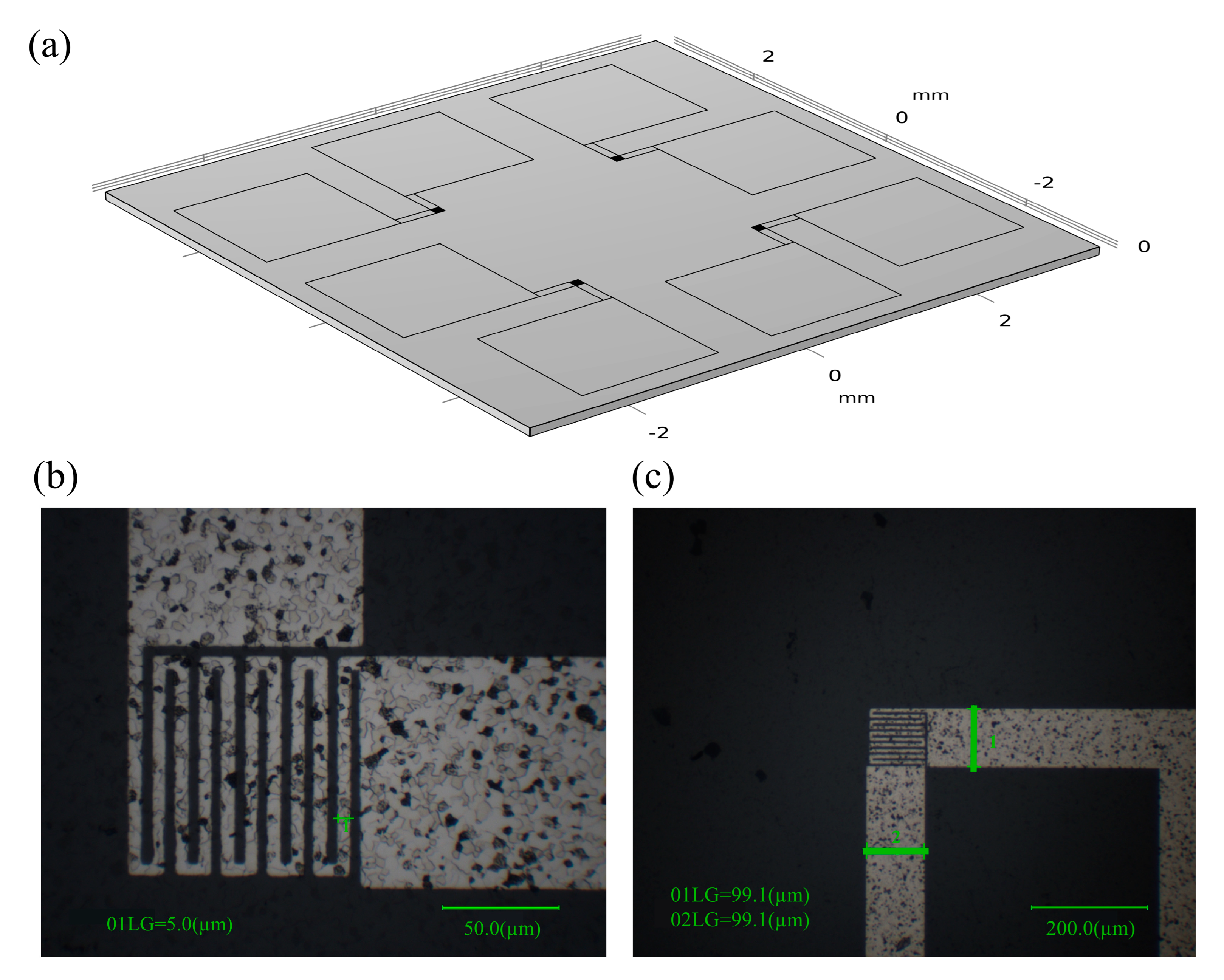
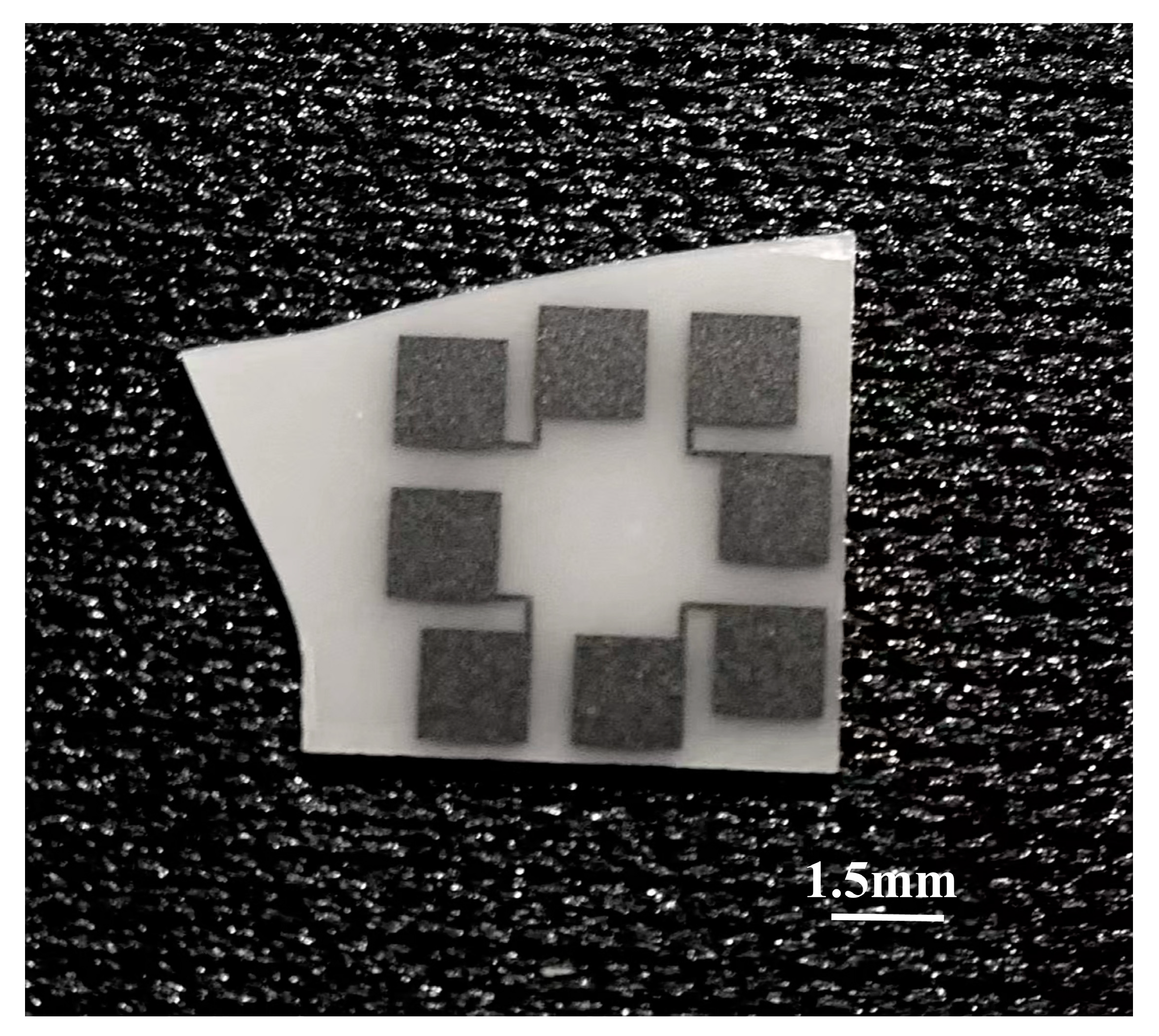
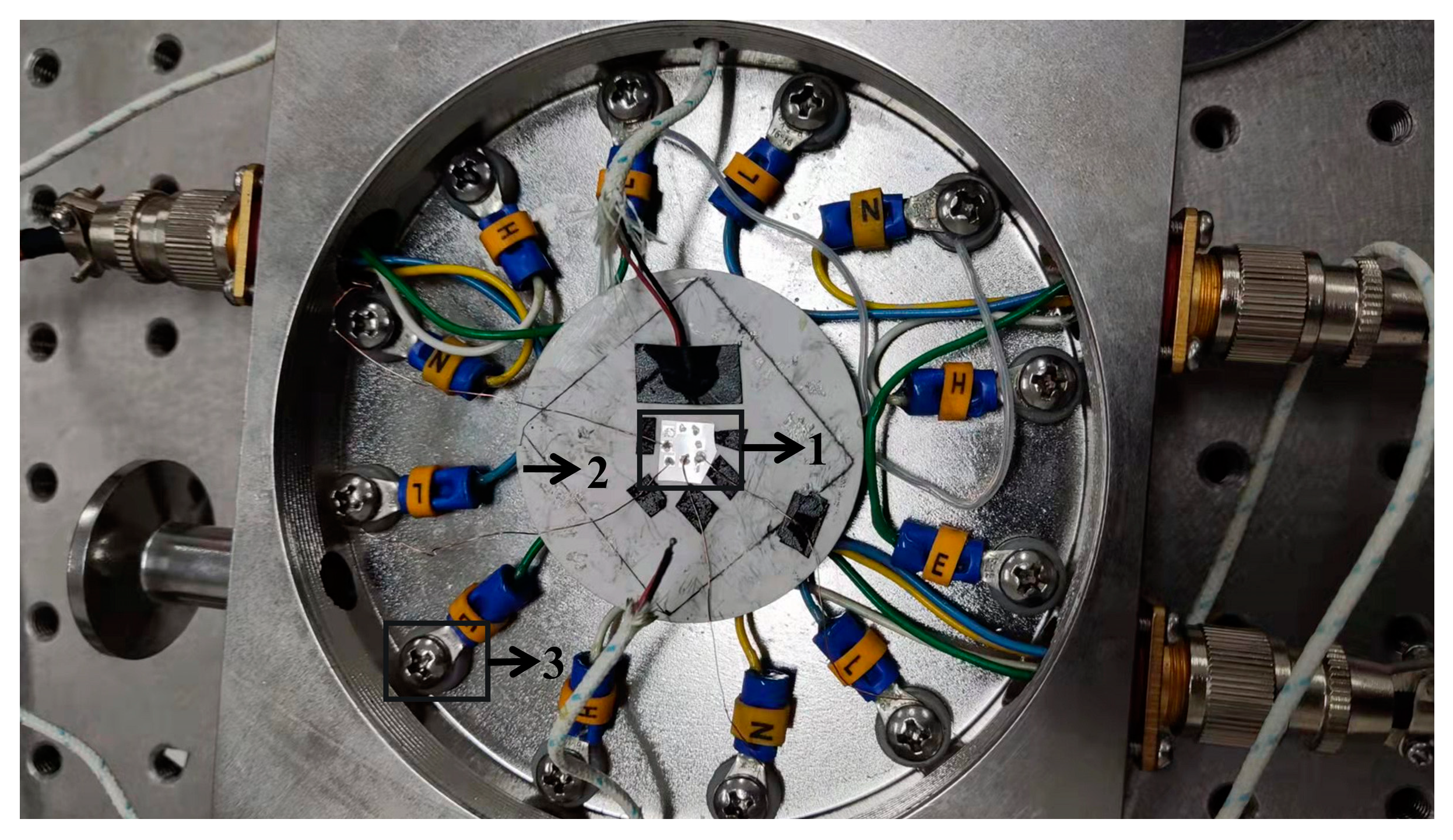
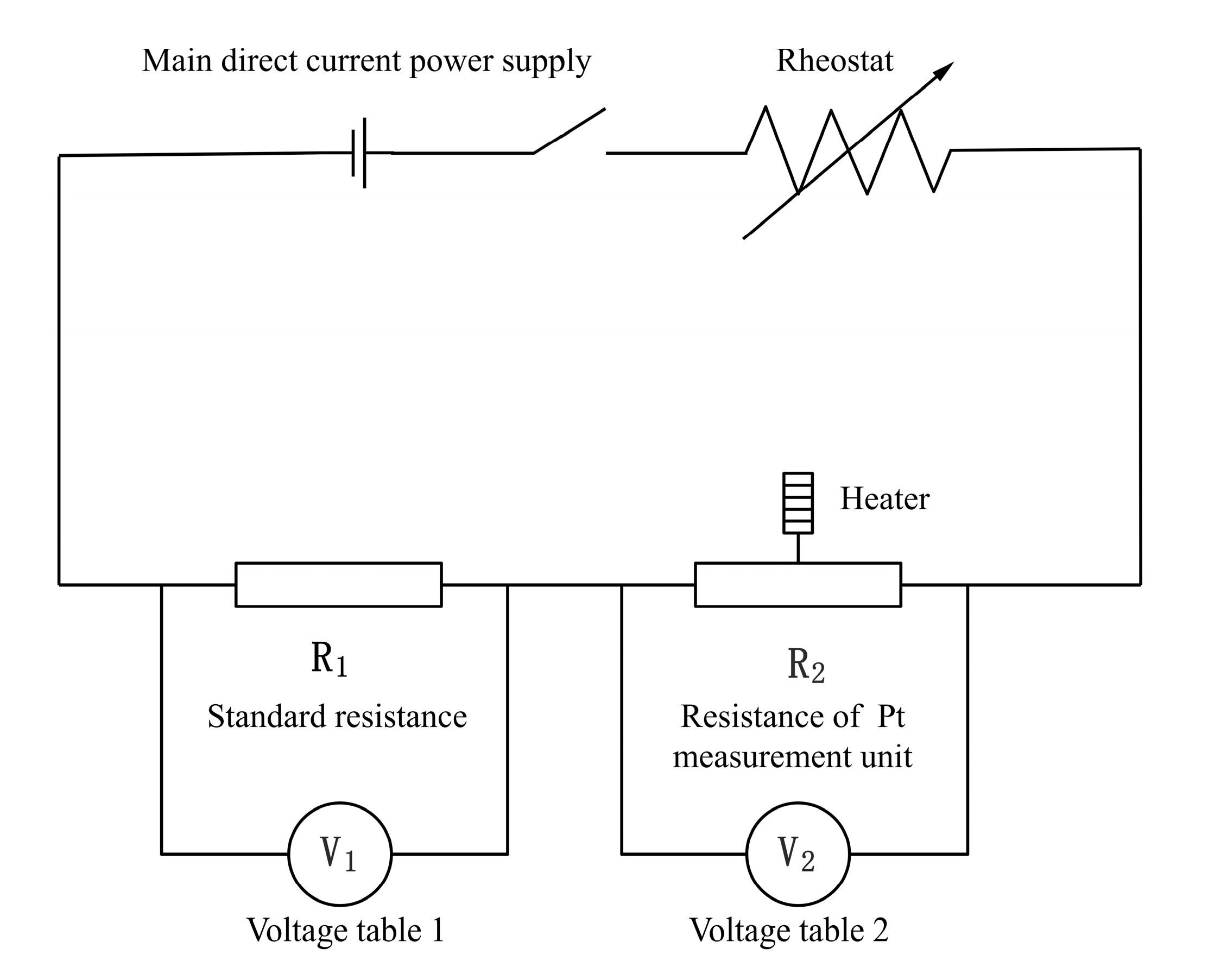
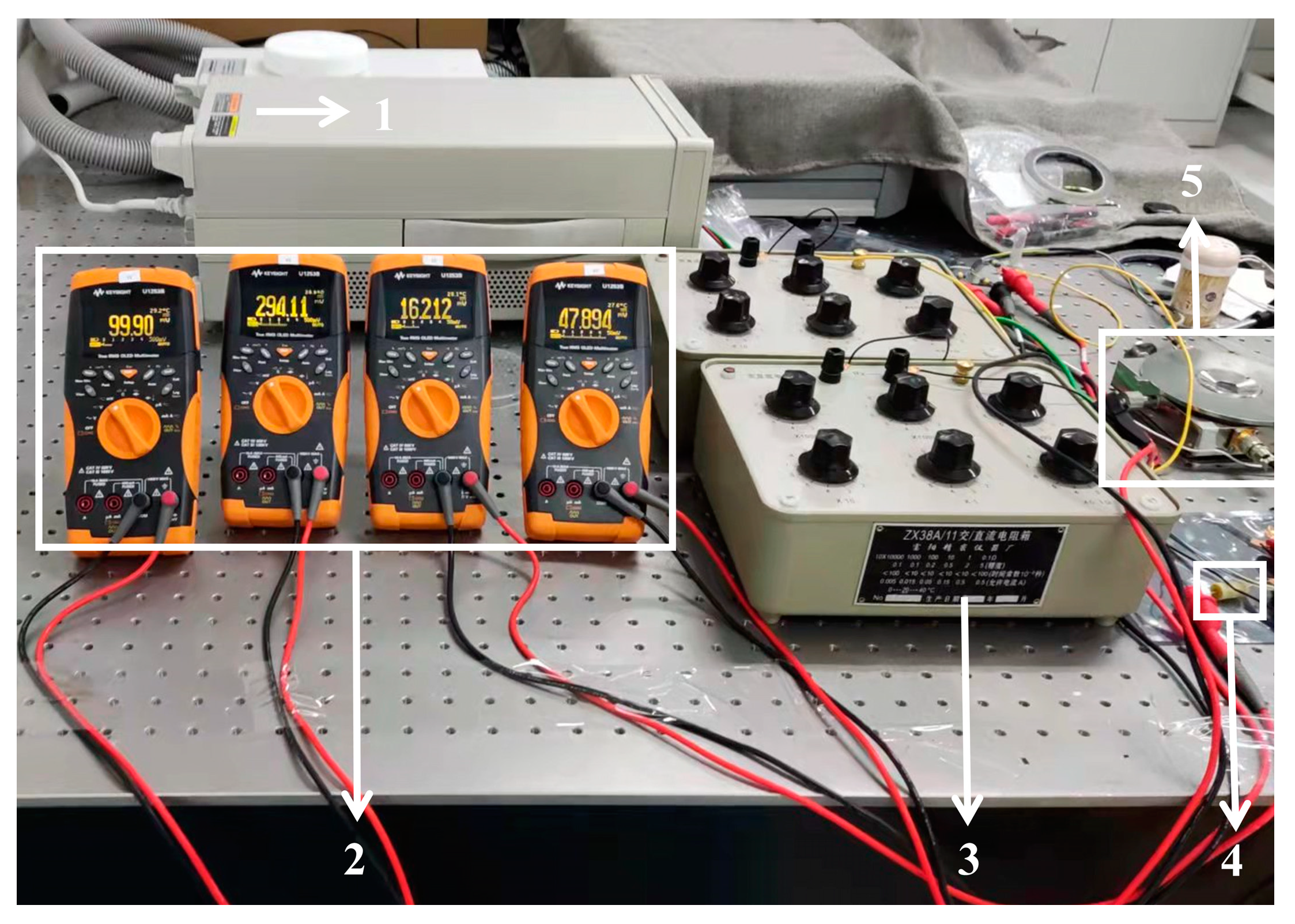
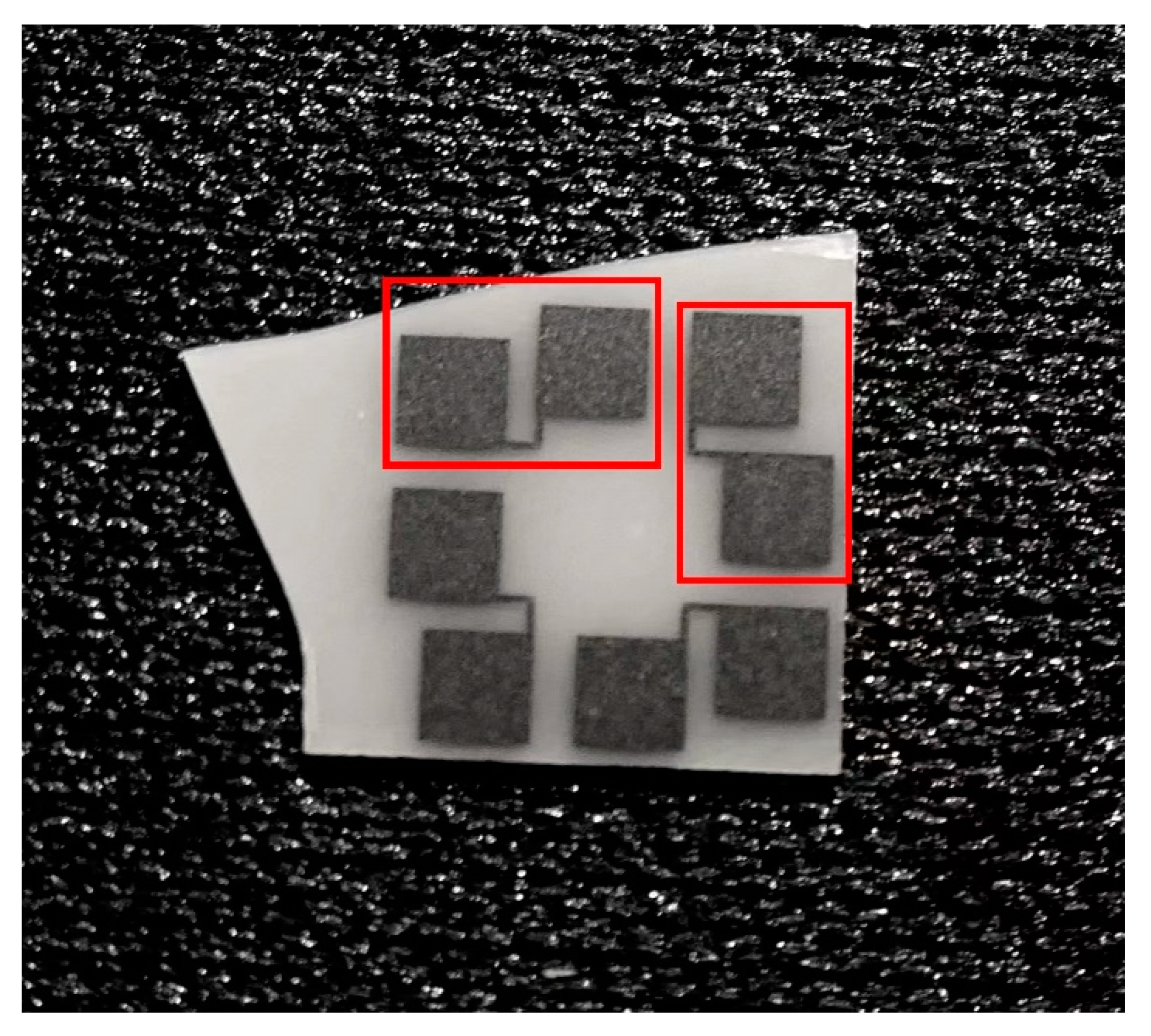
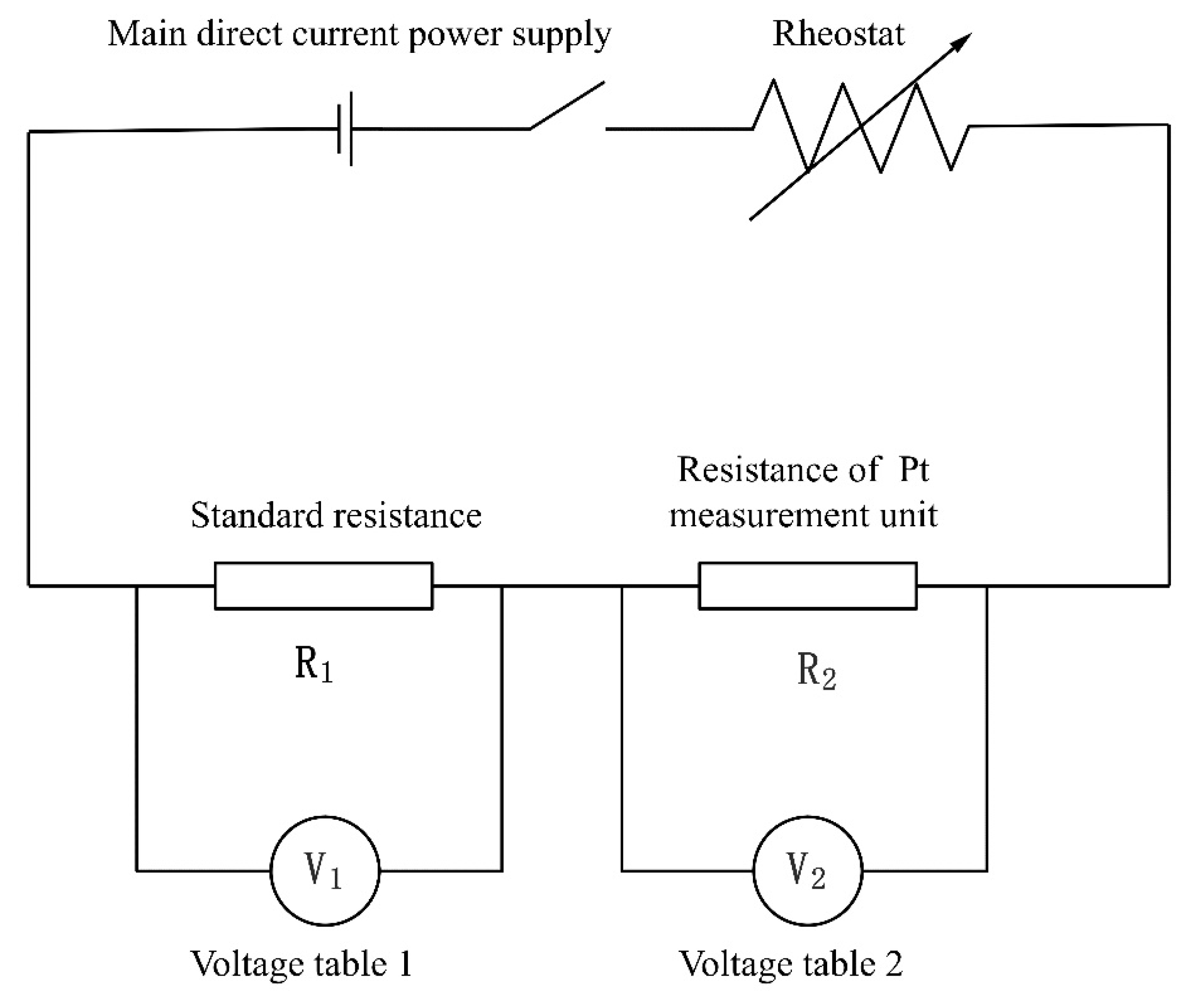
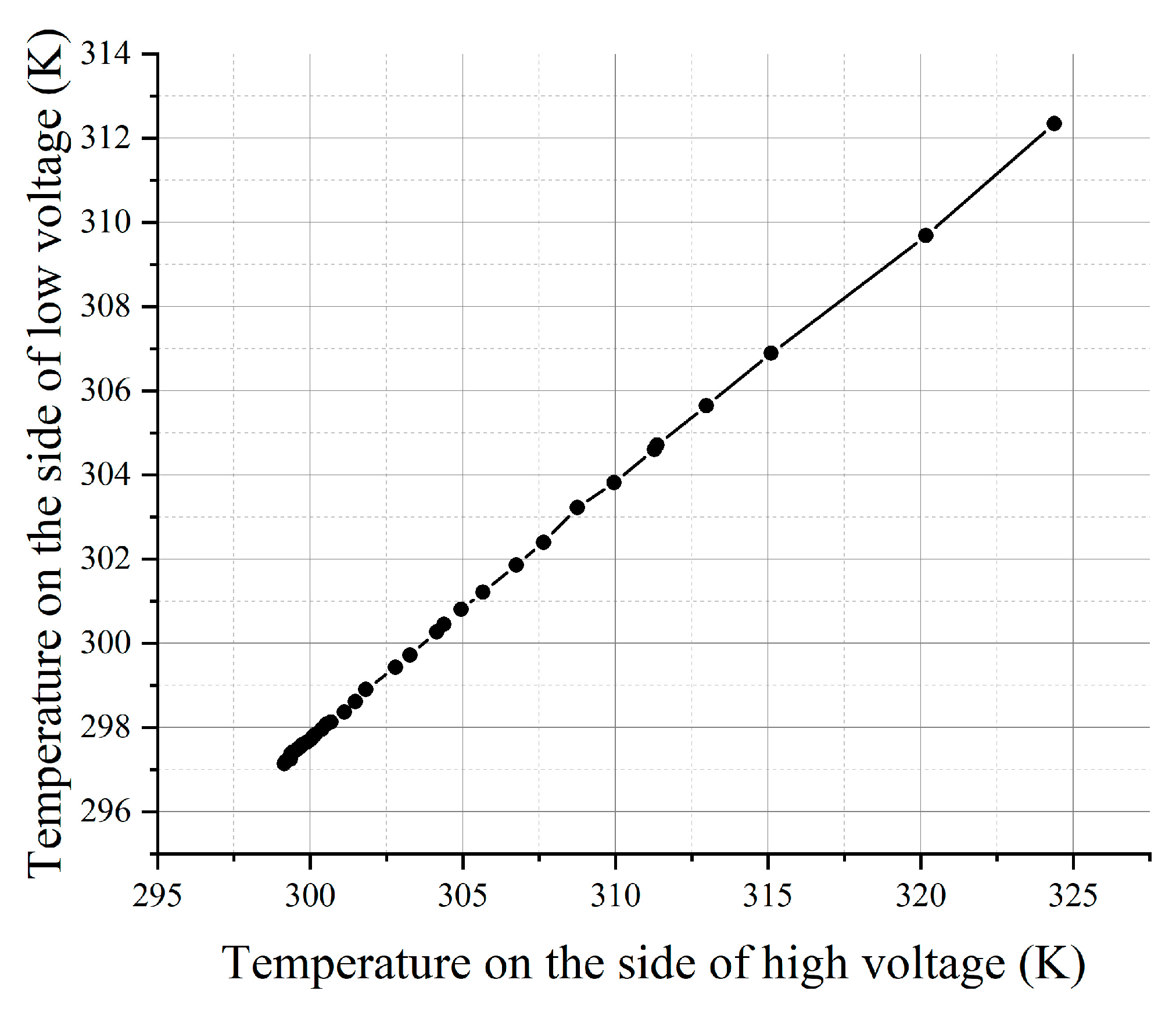

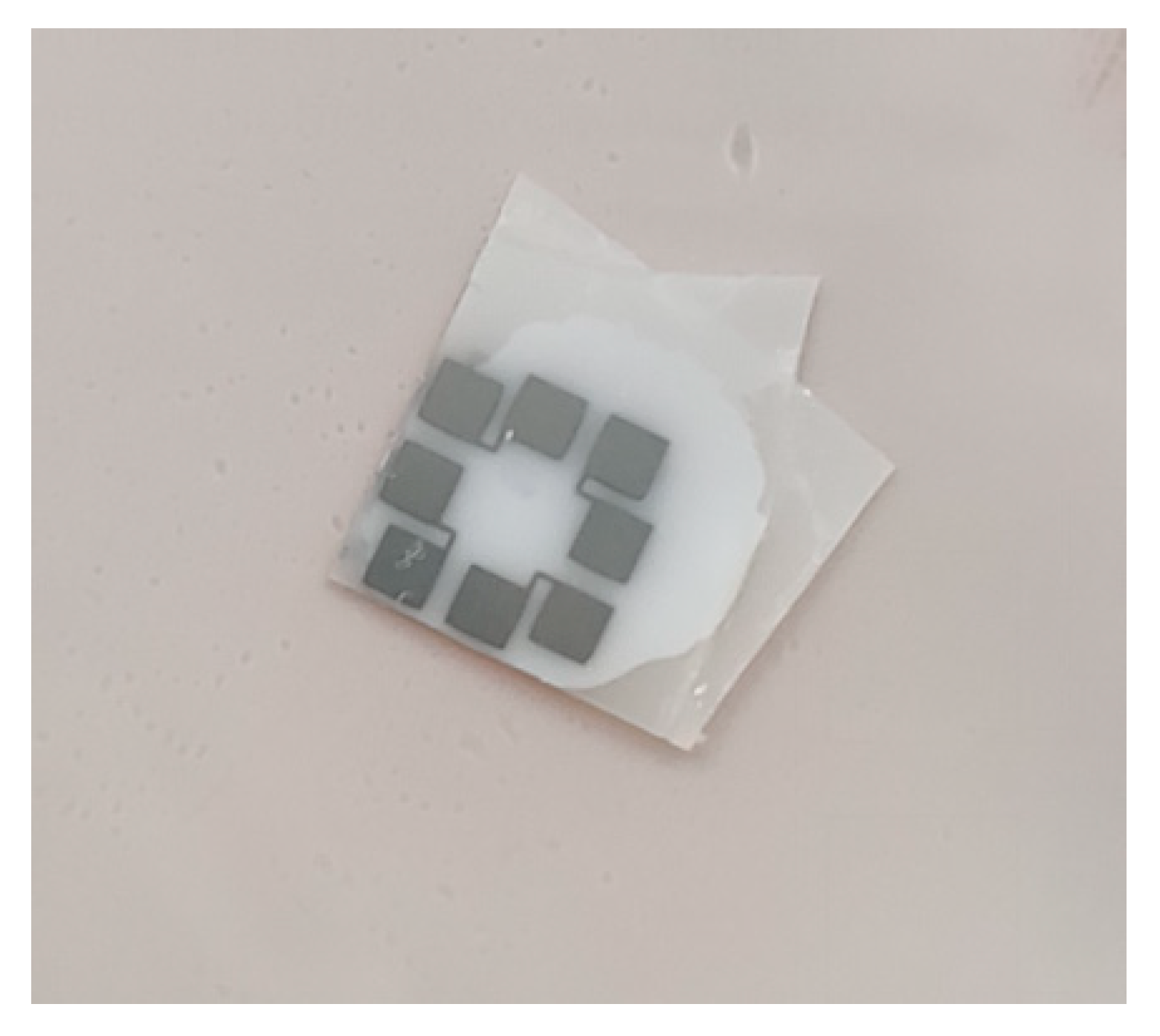
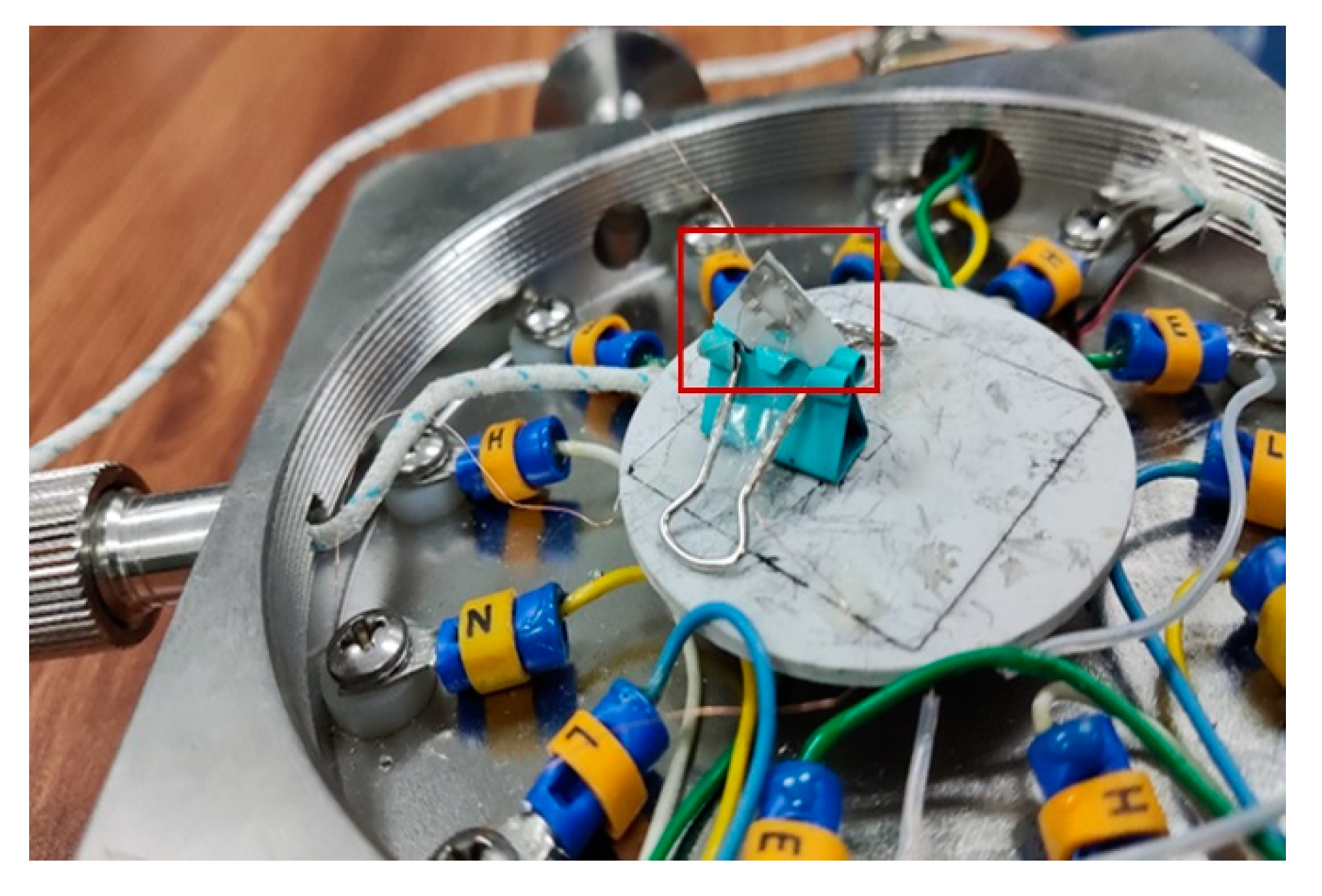
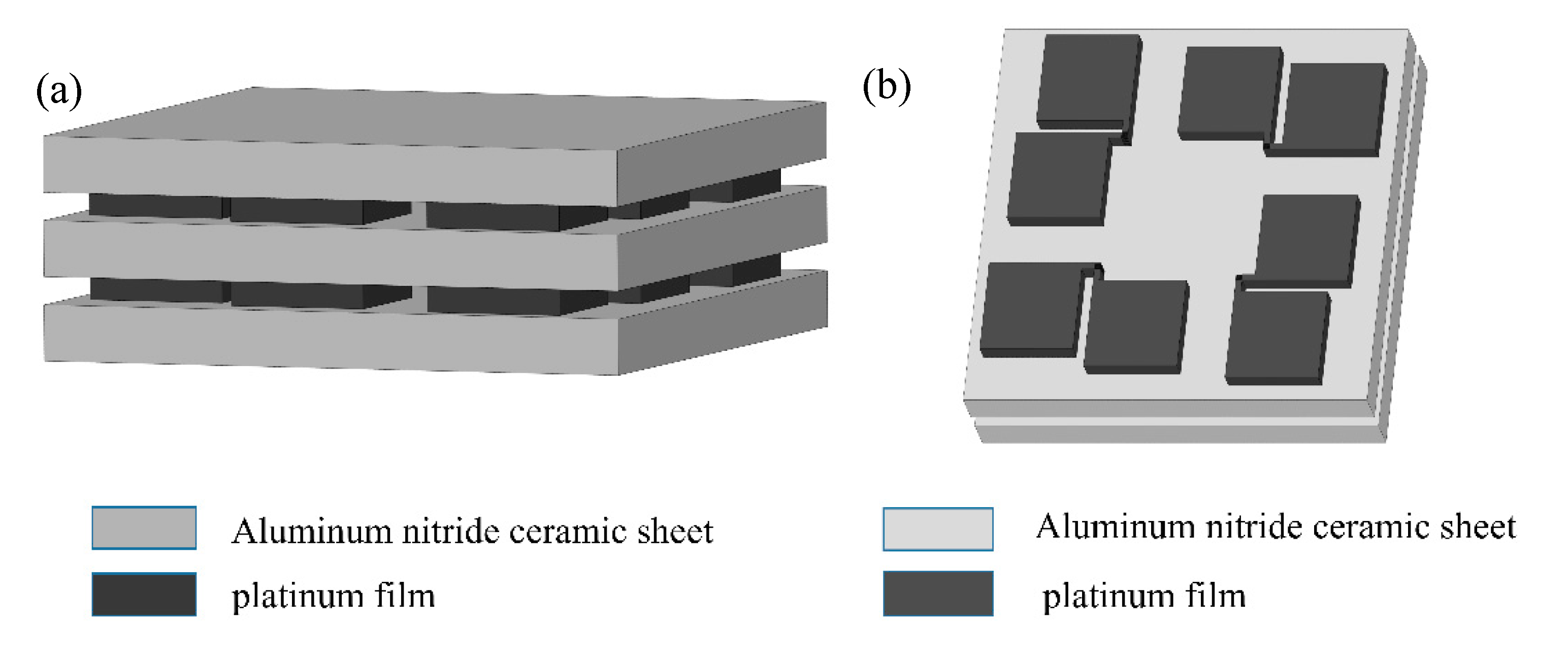

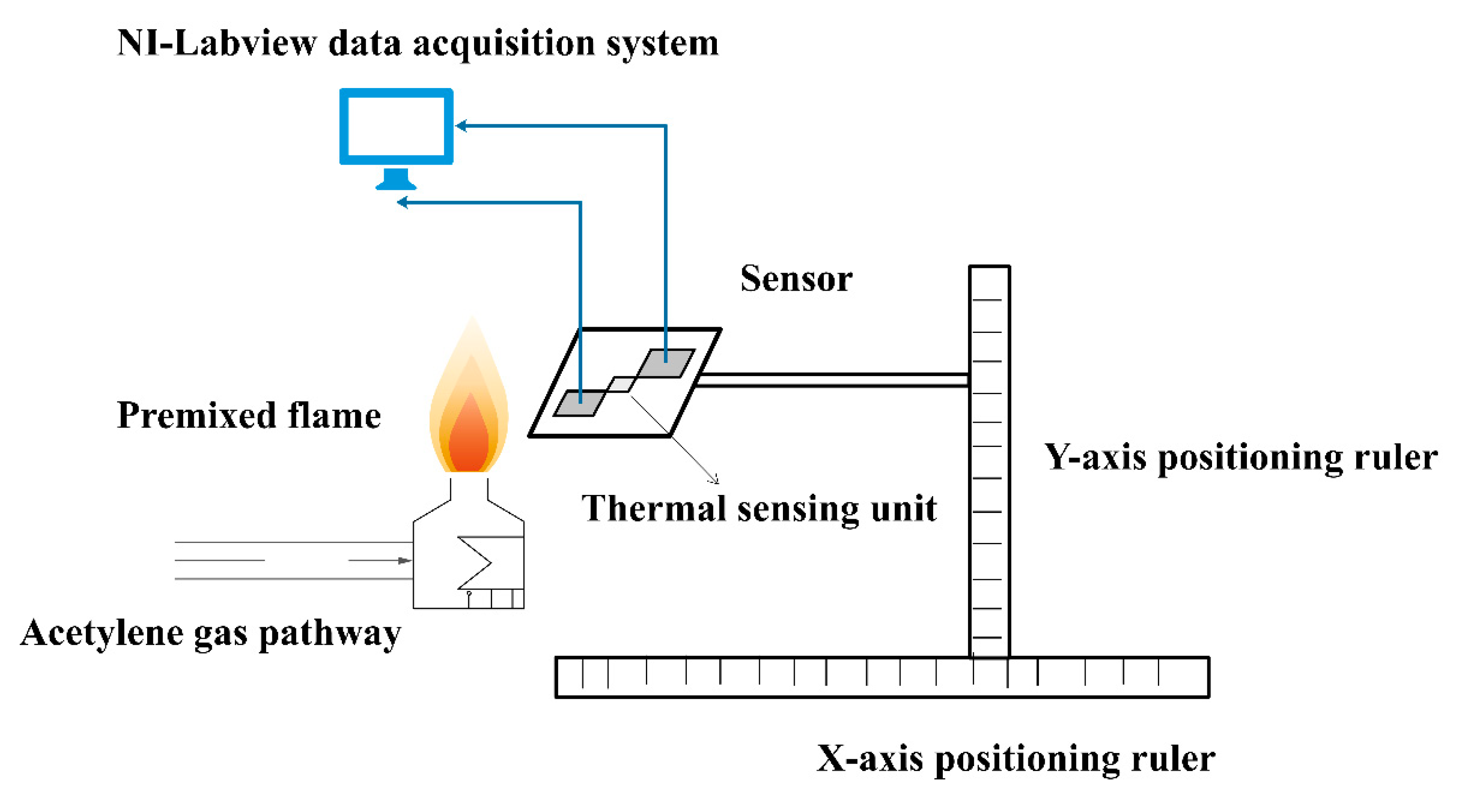
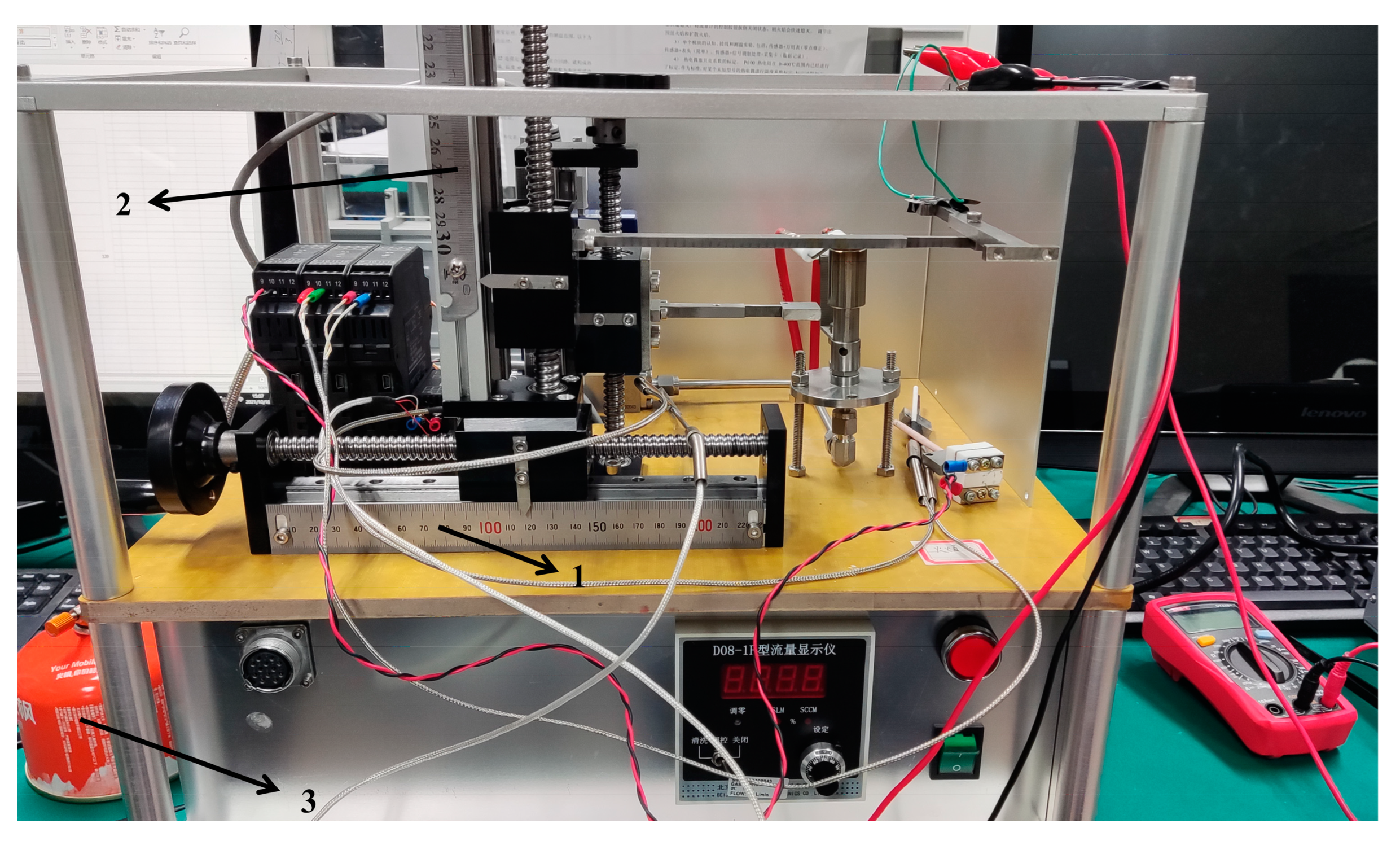
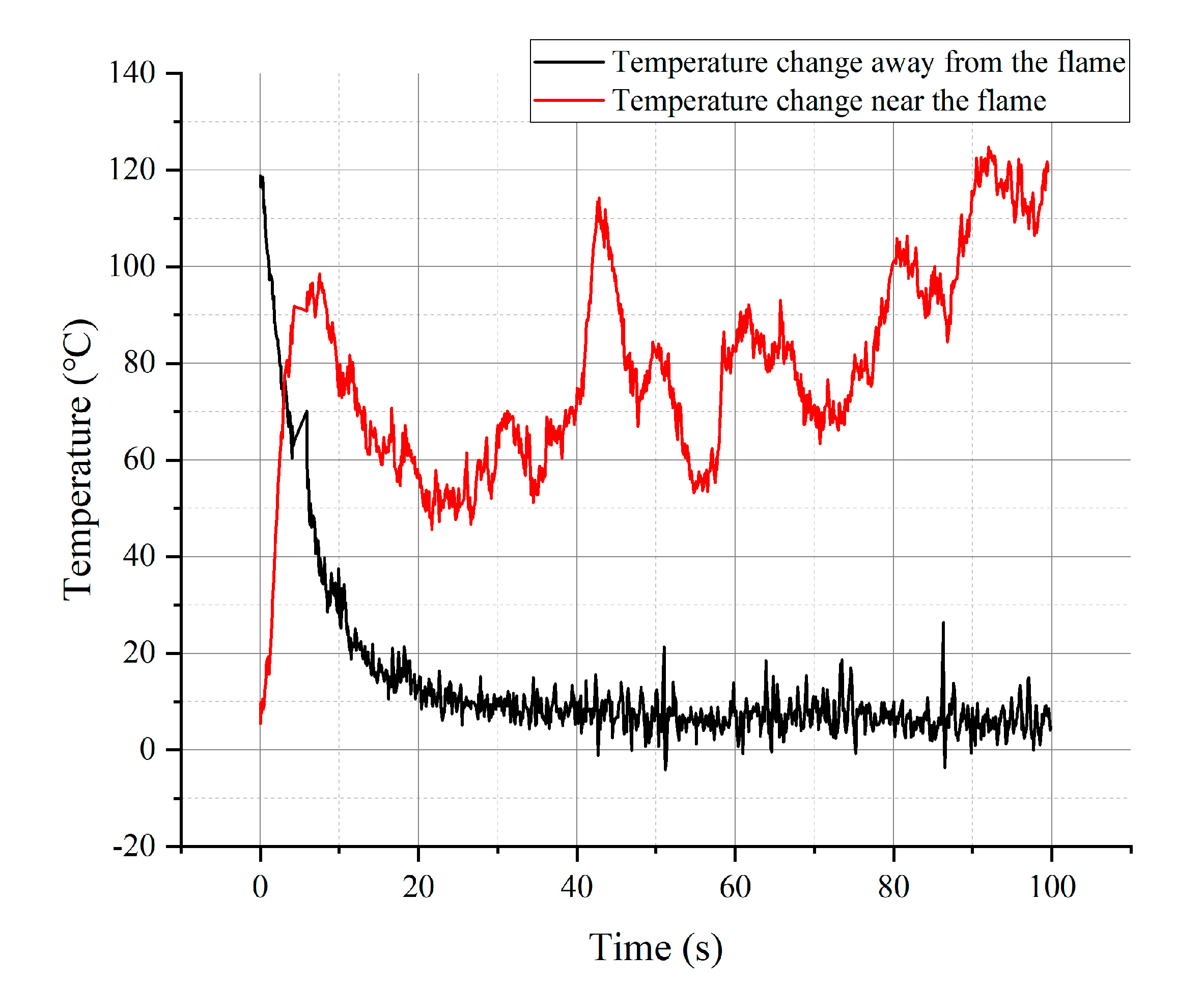
| Initial Resistance | Slope | Resistance Temperature Coefficient | |
|---|---|---|---|
| Sample 1 | 441.09 | 0.7817 | 0.0017722 |
| Sample 2 | 443.50 | 0.7741 | 0.0017454 |
| Sample 3 | 455.20 | 0.7872 | 0.0017294 |
| Sample 4 | 464.82 | 0.8106 | 0.0017439 |
Publisher’s Note: MDPI stays neutral with regard to jurisdictional claims in published maps and institutional affiliations. |
© 2022 by the authors. Licensee MDPI, Basel, Switzerland. This article is an open access article distributed under the terms and conditions of the Creative Commons Attribution (CC BY) license (https://creativecommons.org/licenses/by/4.0/).
Share and Cite
Luo, X.; Wang, H. A High Temporal-Spatial Resolution Temperature Sensor for Simultaneous Measurement of Anisotropic Heat Flow. Materials 2022, 15, 5385. https://doi.org/10.3390/ma15155385
Luo X, Wang H. A High Temporal-Spatial Resolution Temperature Sensor for Simultaneous Measurement of Anisotropic Heat Flow. Materials. 2022; 15(15):5385. https://doi.org/10.3390/ma15155385
Chicago/Turabian StyleLuo, Xuwen, and Haidong Wang. 2022. "A High Temporal-Spatial Resolution Temperature Sensor for Simultaneous Measurement of Anisotropic Heat Flow" Materials 15, no. 15: 5385. https://doi.org/10.3390/ma15155385
APA StyleLuo, X., & Wang, H. (2022). A High Temporal-Spatial Resolution Temperature Sensor for Simultaneous Measurement of Anisotropic Heat Flow. Materials, 15(15), 5385. https://doi.org/10.3390/ma15155385







